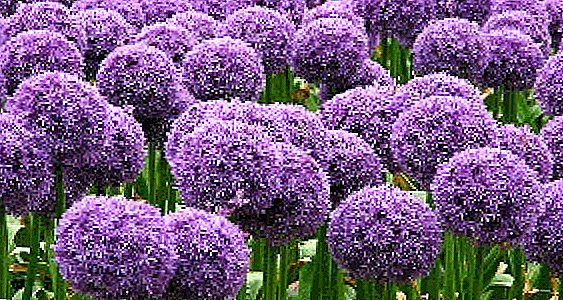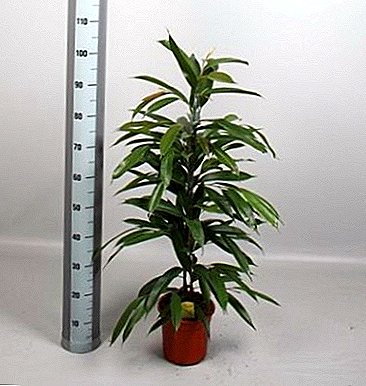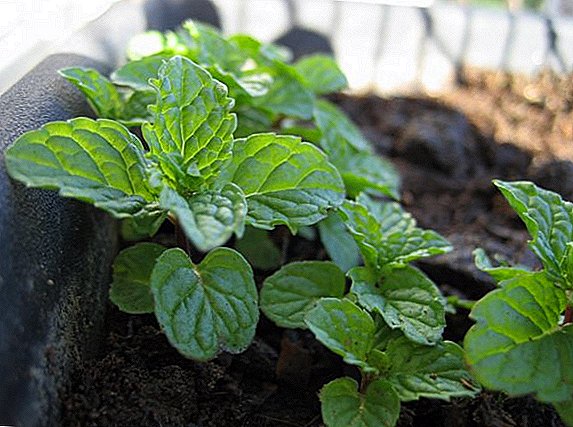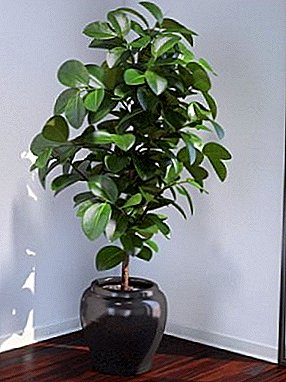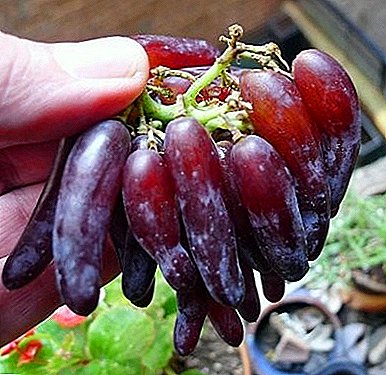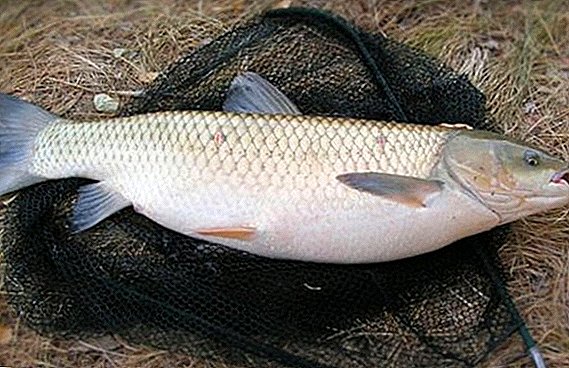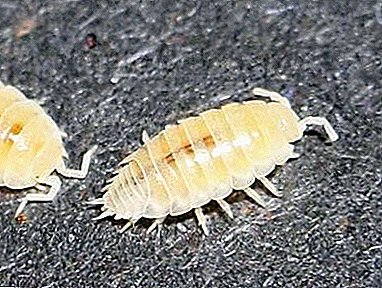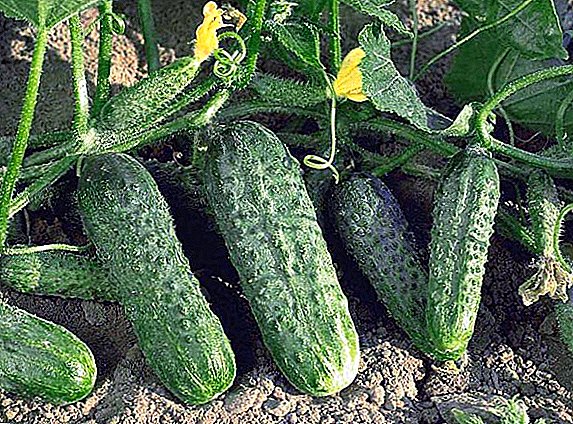 Many gardeners are interested in crops that make it possible to harvest earlier than usual. It doesn't matter if you grow tomatoes, cucumbers or other vegetables - the early or average time of their ripening will be a weighty argument in favor of one or another variety.
Many gardeners are interested in crops that make it possible to harvest earlier than usual. It doesn't matter if you grow tomatoes, cucumbers or other vegetables - the early or average time of their ripening will be a weighty argument in favor of one or another variety.
In this article we will discuss one rather interesting hybrid of cucumbers, which allows you to harvest the first crop in a fairly short time.
Let's see what is a variety of "Crispin F1", as well as what you need to know about the intricacies of its cultivation in open ground and in special greenhouses.
Hybrid description
When describing any culture, an important role is played not only by the characteristics of the fruit, but also by the characteristics of the plant itself, on which these fruits appear, therefore we suggest paying attention to both parts of the Crispin F1 cucumber.
Bushes
This variety is represented by medium grown plants possess lashes of medium length and well developed root system. It must be said that it is precisely the strong roots that supply the plant with all the nutrients it needs, in particular moisture, which in the soil may not be enough.
Leaf plates on cucumbers are not large, although it is easy to notice a slight wrinkling. The color of the leaves depends on the amount of light and heat that comes to them: the more of them, the darker the color will be. About 3-5 greens are formed in each sinus of the bush.
When choosing varieties for cultivation, study the characteristics of cucumbers Taganay, Palchik, Masha f1, Competitor, Zozulya, German, Courage.
Fruit
With the growth and development of seedlings on the bushes are formed the same size fruits are 10-12 cm long and 4 cm in diameter. The mass of one cucumber on average reaches 100-120 g. They have a cylindrical shape and there is a small influx in the upper part. As for the shade, it can vary from green to dark green, and often both variants are found on the same fruit. Also on Zelentsah it is easy to see whitish specks of a rounded shape, light stripes and pubescence with white spikes. The flesh of Crispin’s cucumber is aromatic and crunchy, without any bitterness. In many respects due to these characteristics, fruits are successfully used both fresh to prepare salads, and as the main component of winter harvesting. In addition, these cucumbers perfectly tolerate long-term transportation, which allows them to grow for commercial purposes.
Also on Zelentsah it is easy to see whitish specks of a rounded shape, light stripes and pubescence with white spikes. The flesh of Crispin’s cucumber is aromatic and crunchy, without any bitterness. In many respects due to these characteristics, fruits are successfully used both fresh to prepare salads, and as the main component of winter harvesting. In addition, these cucumbers perfectly tolerate long-term transportation, which allows them to grow for commercial purposes.
Did you know? The breeding of this hybrid variety was done by breeders from Holland, and in 2000 it came into the State Register of the Russian Federation and was positioned as a variety that is ideal for growing in summer cottages, backyard areas and in small farms. Suitable for cultivation in almost all climatic regions, because it can be grown in open soil, and in greenhouses or greenhouses.
Characteristic
One of the main characteristics of "Crispin" is its ability to self-pollination, which significantly simplifies the growing task for a gardener. At the same time, good resistance to various diseases, changes in weather conditions and care errors makes it possible to successfully grow cucumbers even for beginners in this business.
If you want to get the most bountiful harvest, then the lash should be tied to a support. But this is not a requirement and the fruits will be formed even when they are placed horizontally (often just spread along the ground).
This variety is not as dependent on a specific temperature as other cucumbers, and even in the first half of the growing season the heat will not be disastrous for it. On average, with 1 square. m collect about 6.5 kg of Zelentsov.
Advantages and disadvantages
The main advantages of Crispin’s cucumber varieties should be a relatively short period of ripening, resistance to diseases and other negative external factors, high yields and evenness of fruits. Moreover, a positive point in the cultivation of culture is the complete absence of significant minuses of cultivation.
Growing seedlings
When growing cucumbers of the described varieties, you can sow the seeds immediately in open ground, but, as practice shows, you can achieve a bountiful harvest with the help of pre-growing seedlings. This not only allows you to get a harvest in record time, but also saves the seed while at the same time allowing you to better protect young plants in the early stages of their development.
Did you know? Cucumbers glorified the Ukrainian city of Nizhyn, because it was they who provided the entire imperial court during the reign of Catherine II until 1917. In 2005, the Nezhin cucumbers even installed a monument.
Selection and preparation of seeds
In most cases, seeds are sent to the market or to specialty stores, and it is good if you have already decided on the most suitable variety for you. Of course, when buying in a store, you are unlikely to open the package and inspect its contents, which means that when choosing seeds of the Crispin hybrid, you will have to follow the standard procedure: check the expiration date (indicated on the package) and evaluate the appearance of the bag, must be crumpled, wet, dirty, etc.
Of course, when buying in a store, you are unlikely to open the package and inspect its contents, which means that when choosing seeds of the Crispin hybrid, you will have to follow the standard procedure: check the expiration date (indicated on the package) and evaluate the appearance of the bag, must be crumpled, wet, dirty, etc.
However, even if you manage to acquire the highest quality and good seeds, without proper preliminary preparation, they will not be able to bring the desired result. Many gardeners advise, in spite of the protective layer applied by the manufacturer, to carry out preplant seed treatment.
Therefore, opening the seed packaging at home, immediately before planting, it is necessary to soak all seed in water, and then calibrate: for 10-15 minutes, the seeds are dipped into a saline solution (30-50 g of salt are taken per 1 liter of water) and select weak and lifeless, leaving only large and full-bodied specimens.
A suitable material should be heated by placing it in a gauze bag and dropping it in a thermos with water for 1.5-2 hours (liquid temperature should be at + 50 ... +55 ° C). To disinfect the planting material, it is treated with a solution of potassium permanganate, dropping in the solution of potassium permanganate for 25-30 minutes. After completing this procedure, the seeds should be washed under running water.
Important! If you want to enrich your seeds with useful microelements, you can use ashes diluted in water (2 tablespoons per 1 liter of liquid), in which the seeds are soaked for 3 hours, and then removed and washed with clean water.
Further preparation for sowing cucumbers "Crispina" provides for the organization of the most suitable substrate.
Soil preparation
Experts recommend sowing seeds in light and nutritious soil, or directly into peat pots.
With the latter option, and so everything is clear, but if you are going to grow seedlings in ordinary pots, then you have to fill them with a mixture of peat, humus and sod land in a ratio of 3: 1: 1. In addition, ammonium nitrate, potassium sulfate and superphosphate are also added to the resulting composition.
Be sure to follow the acidity indicators of the prepared substrate - they should not exceed 6.2-6.5 pH, and in order for the root system of cucumbers to have enough space for normal development, the diameter of the pots should not be less than 9 cm.
When planting seeds immediately in the greenhouse or on the garden, the preparation of the site provides for the formation of small ridges along future rows with cucumbers, which make manure and mineral fertilizers. They will be able to guarantee more efficient plant development. In closed soil, the ridge height is usually 15–20 cm, and a distance of 0.9–1.0 m is maintained between the rows. 
Important! Immediately after sowing and before the appearance of the first shoots, the temperature regime in the room with seedlings must be kept within + 25 ... +28 ° C. As soon as the young sprouts hatch, it is reduced in the daytime to + 18 ... +20 ° C, and at night to + 14 ... +15 ° C, timely watering and ensuring adequate ventilation.
Planting cucumbers
If you grow Crispin cucumbers in a seedling way, then approximately on the 25th day after the first seedlings appear, they should be transplanted from the pots to a permanent growing place, the soil in which should warm up to +17 ° C. Of course, it would be better to transplant to the greenhouse, but if you decide to plant young plants on the garden bed, then take care of appropriate shelter for them (for example, stretch the film or use special covering materials).
When planting, observe the distance between plants of 35-45 cm, which directly depends on the width of the row spacing. On average, 100 square meters. m plantings should account for about 200-250 seedlings. Stepping back from the plants by 5–20 cm, you can put tubes for drip irrigation of cucumbers, which will significantly reduce water consumption during watering and make the application of additional fertilizers and protective preparations (from pests and diseases) easier task. Also, a well-established shelter site with plantings mulch film. 
Sprout care
Cucumbers are light-loving plants, which is why they are recommended to be planted only in well-lit areas, or a maximum in partial shade. When growing seedlings "Crispin F1" at home with the appearance of the first sprouts, it must be transferred to a more illuminated sill and periodically lift the film to air the seedlings.
If you planted cucumbers immediately in open ground, then additionally provide cover for the plants from the wind. On the role of natural fencing is well suited corn, which is sown on both sides of the cucumbers in one row. In this case, the south side can not be closed.
In order for sprouts to grow and develop normally, the average daytime temperature must be kept at +22 ° C, but small errors are possible in both directions. At the same time, the slightest frosts can ruin immature shoots. Of course, it is much easier to control the process of growing seedlings at home, which means you will have more viable and stronger seedlings. 
How to care for adult plants
It may seem to someone that after successfully growing seedlings and transplanting them to a permanent place of growth, the most difficult is over. But the abundant and tasty crop of Crispina cucumbers largely depends on the care of the plants during the formation of the ovaries. Therefore, it will be useful for each gardener to learn how to properly water, fertilize, and to retain, and also to treat the described plants from pests and typical diseases.
Watering
Any variety of cucumbers can not do without regular watering, especially since this vegetable, in principle, belongs to moisture-loving plants that prefer high humidity. The introduction of fluid into the soil is an important component of caring for seedlings during the entire growing season and fruiting period, because with a lack of water it is likely that even Crispina, which is not prone to bitterness, will produce bitter fruits.
Important! Watering should be done only with the use of warm water, otherwise the plants will be oppressed and may be affected by rot.
 For the preservation of moisture in the soil around the bushes are covered with a layer of mulch, the role of which is perfectly suited for organic materials such as wood chips and peat. They not only maintain the moisture level at the proper level, but also, rotting away, emit a sufficient amount of heat and feed the substrate with useful trace elements.
For the preservation of moisture in the soil around the bushes are covered with a layer of mulch, the role of which is perfectly suited for organic materials such as wood chips and peat. They not only maintain the moisture level at the proper level, but also, rotting away, emit a sufficient amount of heat and feed the substrate with useful trace elements.Do not forget that too frequent introduction of liquid into the soil causes its compaction, which is why the cucumber roots often lack air. To the root system of the plants did not suffer from a lack of oxygen, experts advise to alternate watering and loosening the substrate.
Only you need to perform the procedure is not the classical way, but using forks, which pierce the soil. So you do not damage the delicate roots of cucumbers and organize a sufficient flow of air to the root system.
Fertilizer
Variety "Crispina" boasts massive aboveground and underground parts, so it is logical to assume that cucumbers can not do without adequate nutrition. The roots of the plant respond well to the introduction of fertilizing by applying drip irrigation through the local system, but even if you don’t have it, it’s not scary, you can always dissolve the selected mixture and spill it under the bushes.  After several samples of fruits, all plants are fertilized with nitrogen-potassium compounds, the role of which is perfectly suited for organic mixtures (for example, a solution of manure or chicken manure) or mineral mixtures, for example, calcium nitrate with potassium sulfate or potassium nitrate.
After several samples of fruits, all plants are fertilized with nitrogen-potassium compounds, the role of which is perfectly suited for organic mixtures (for example, a solution of manure or chicken manure) or mineral mixtures, for example, calcium nitrate with potassium sulfate or potassium nitrate.
Important! When using mineral compounds in closed soil, one should not forget about the necessity of introducing nitrogen in the nitrate form, and when using ammonium it should not exceed 20% of the total amount of nitrogen introduced in the mineral form. Feedings are performed once every 10 times.-14 days.
Masking
When grown in greenhouse conditions, cucumber bushes of this variety form in one stalk with lateral stepsons. At the same time, in the first 4-5 leaf axils of the main stem, it is necessary to perform a glare - all stepchildren and ovaries are removed. In the next 3-4 nodes, you need to leave only one ovary and completely remove the stepsons. Thus, each plant will be able to stock up on nutrients to the maximum and bring an early abundant harvest. In the 4-5 knots located further, all the formed ovaries are left, and the stepchildren pinch after the 1st leaf. Then, moving up the stalk, they are pinched after the 2-3rd leaf, taking into account the thickening of the plantings. As soon as the main stem reaches a horizontally installed trellis, it should be carefully wrapped around it and lowered down, pinching at a distance of 1-1.5 m from the soil level.
In the 4-5 knots located further, all the formed ovaries are left, and the stepchildren pinch after the 1st leaf. Then, moving up the stalk, they are pinched after the 2-3rd leaf, taking into account the thickening of the plantings. As soon as the main stem reaches a horizontally installed trellis, it should be carefully wrapped around it and lowered down, pinching at a distance of 1-1.5 m from the soil level.
As the plant grows, or, more correctly, the plants that have become yellowed, thickening the planting, must be periodically removed, which will improve air exchange in the greenhouse and help protect cucumbers from the development of diseases associated with air stagnation.
Did you know? The famous French commander Napoleon Bonaparte loved cucumbers so much that he even promised a reward in the form of the equivalent of 250 thousand dollars to anyone who would think of a way to keep them for long periods during their hikes. True, this amount has not been able to get anyone.
Protection against diseases and pests
Like many other cucumber varieties, Crispin F1 plants often suffer from rot (stem or root). For the most part, these diseases afflict young seedlings at the seedling stage, therefore, experts advise treatment with systemic preparations.  After the seedlings are moved into the open soil, their support with the help of chemical compounds continues. In order to provide the plants with the maximum possible protection, the treatment is carried out before the formation of the fruit, with regularity of 8-14 days, depending on the weather. If there is a need for additional spraying during fruiting, all ripe cucumbers should be pre-harvested and processed again. Resume fruit picking will be no earlier than 3 days.
After the seedlings are moved into the open soil, their support with the help of chemical compounds continues. In order to provide the plants with the maximum possible protection, the treatment is carried out before the formation of the fruit, with regularity of 8-14 days, depending on the weather. If there is a need for additional spraying during fruiting, all ripe cucumbers should be pre-harvested and processed again. Resume fruit picking will be no earlier than 3 days.
To cure cucumbers from ailments and rid the area of weeds, it is recommended to apply formulations registered in a specific region. Experts in the field of plant protection products will provide you with detailed information on a particular drug and help you find the most effective dosage.
The most modern methods of protecting cucumbers from pest attacks are biological. For example, to remove spider mites living on the leaves of a plant from Crispin’s plantations, soybean leaves should be spread around the perimeter with phytoseiulus present on them.  To help with the whitefly tobacco will help with the domes of the Enkarzia rider, and the aphidius rider or ladybugs come in handy in the fight against aphids. All this can be easily found in biological laboratories at greenhouses.
To help with the whitefly tobacco will help with the domes of the Enkarzia rider, and the aphidius rider or ladybugs come in handy in the fight against aphids. All this can be easily found in biological laboratories at greenhouses.
As you can see, the cultivation of Crispin cucumbers will not take much energy from you, because planting and caring for them are not much different from similar actions when cultivating any other varieties. That is, if you make quite a bit of effort, then you will get tasty and fragrant fruits on the table.


